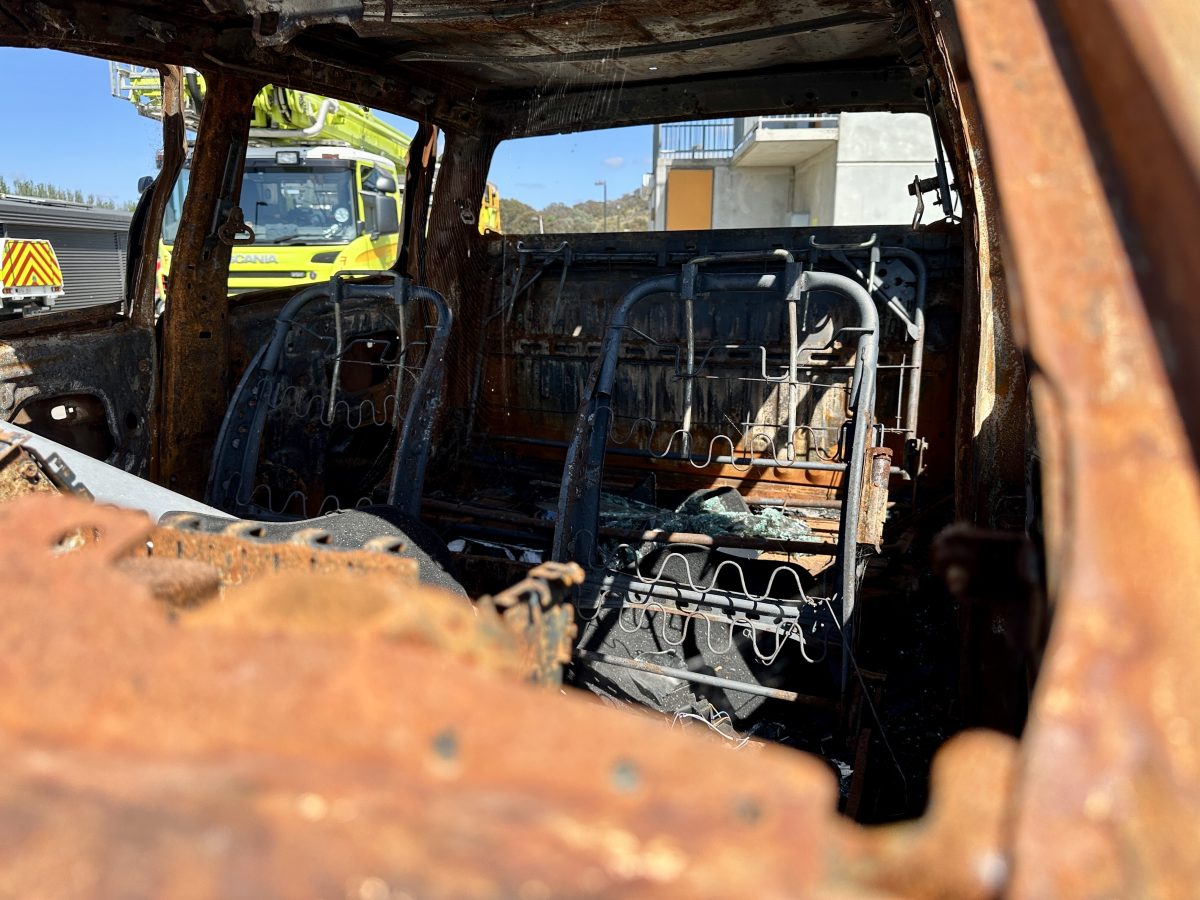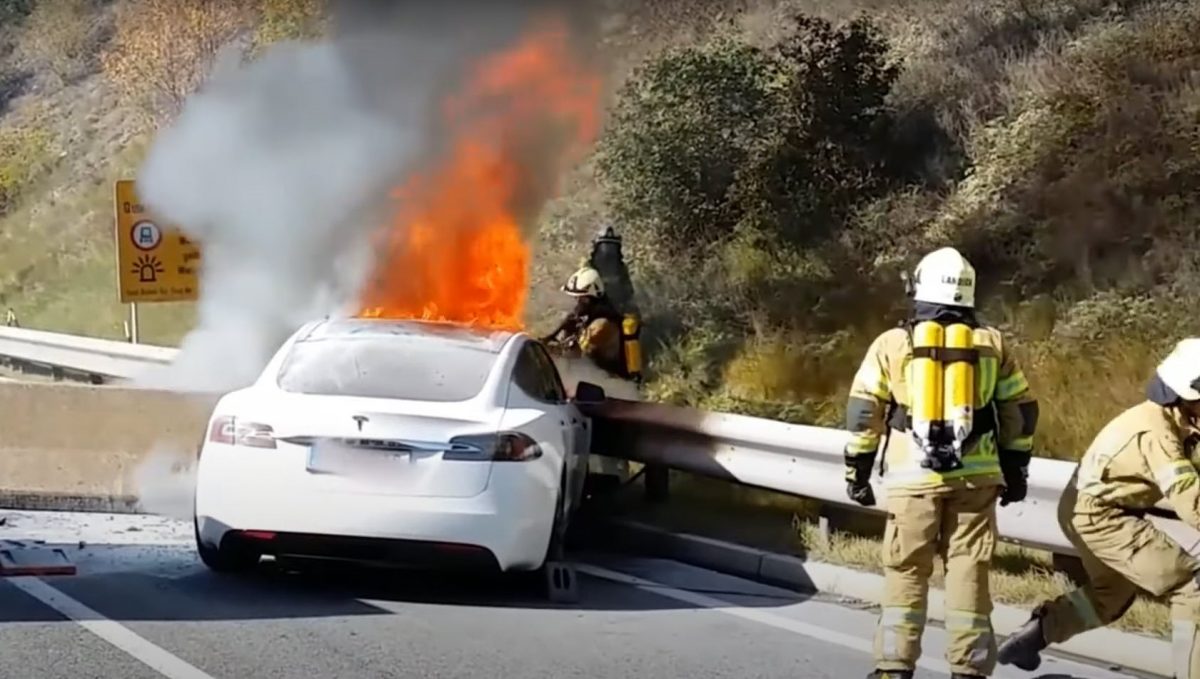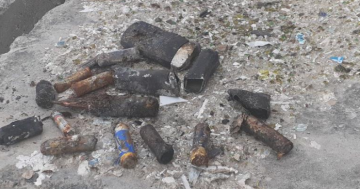
ACT Fire & Rescue superintendent Greg Mason next to a burnt-out car. Photo: James Coleman.
The grass around Canberra might be sprouting at the moment, but the time is coming when this will slow and it will turn brown and dry.
The ACT’s emergency services have a warning for you when this happens.
“I would encourage people to be aware of where they’re parking,” ACT Fire & Rescue superintendent Greg Mason says.
“Don’t park in the long grass.”
In November last year, at the Spilt Milk music festival at Exhibition Park in Canberra (EPIC), the hot exhaust system of an idling car lit the long grass underneath and the resultant fire took out not only that car but several others alongside it.
“Catalytic converters in the car’s exhaust system operate at very high temperatures,” Greg says.
“If they’re in contact with grass or any sort of fuel, there’s always the potential for fire.”
ACT Fire & Rescue says the number of car fires in the ACT has been trending downwards over the past seven years, and this looks set to continue into 2024. They expect to attend about 130 cases next year.
[Insert video here]
Car fires are generally quite random in their time of day and location, but sometimes there’ll be a suspicious spate – all on weekends, late at night, and tucked away in remote locations.
“The reasons people engage in such behaviour varies, depending on whether the car is stolen and they’re trying to destroy evidence, or if they’re trying to commit some sort of insurance fraud,” Greg says.
It doesn’t take long for them to find out.
“We look at the vehicle post-fire, and if the fire started on the inside of the car, for instance, that’s not generally where there are volatile fuels, which leads us to believe it is suspicious. So we can determine that way.”

ACT Fire & Rescue expect about 130 car fires in 2024. Photo: James Coleman.
Non-suspicious fires can typically be traced to the engine, and often times, “defective fuel systems”.
“There used to be certain models of cars known for catching fire, but it can be a wide variety of things. Sometimes something has occurred during a car’s service that has led to the fire.”
A car fire can go from a smoulder to a full blaze within 10 minutes, with temperatures rising to between 700 and 800 degrees Celsius.
“A car has a high fuel load – there are a lot of plastics and foam within the makeup of the vehicle, and obviously a fuel source of some sort,” Greg explains.

The interiors of cars are full of many plastic materials that create toxic fumes when burnt. Photo: James Coleman.
As for the bangs you’ll hear during a car fire, they’re not an indication a Hollywood scene is on the way and the car is about to blow into smithereens.
“Often, the air in the tyres is a source for potential explosions,” Greg says.
“Windows cracking and airbags deploying might be other noises you’ll hear.”
Crews only approach after they’ve armed themselves with PPE and breathing apparatus and recommend passers-by maintain their distance and avoid standing in the poisonous smoke plume. If you haven’t already, phone 000.
The strategy is simple – dump water from a tanker or nearby hydrant on the fire.
“It may take 10 minutes to get to a point where we can get closer to the vehicle and ascertain the cause of the fire and anything that may be in the vehicle,” Greg says.
ACT Fire & Rescue has yet to tackle an electric car fire, but from previous encounters with e-scooters and batteries, they already realise it’s a very different beast.
Emergency services spent two days at the Beam recharging station in Fyshwick in May 2021 after an e-scooter caught fire and then reignited six weeks later.
Then there was the fire that gutted the Resource Management Centre in Hume on Boxing Day last year, traced to batteries that made their way into the recycling stream.
It all comes down to ‘thermal runaway’. In the same way a mobile phone heats up when being charged, when a car battery is damaged or pierced, the energy escapes in the form of extreme heat. A fire or explosion can result, with temperatures reaching 1600 Celsius.

A Tesla on fire overseas. Photo: Screenshot.
‘Drowning’ the fire with a deluge of 2000 to 60,000 litres of water seems to be the only current option (for perspective, the average conventional car fire uses less than 1400 litres).
This approach isn’t likely to change anytime soon.
“With the research we’ve done both nationally and internationally, the best medium we can use at the moment is water,” Greg says.
“There’s a lot happening in this space around EVs and EV fires, and a lot of different approaches being taken by manufacturers to combat fires of this nature, but as of yet, there hasn’t been any other method proven to us to be safe and effective for our crews.”














